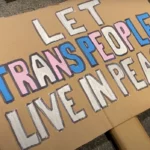Blog Post
Trans activists release “Style Guide” demanding that the media refuse to interview those who disagree with them
By Jonathon Van Maren
In a column for The Stream the other day, I observed that the colonization of the mainstream media by the trans movement happened almost overnight, noting that some day I hope an enterprising journalist tells the story of how trans activists managed to get the entire mainstream media to sign on to their agenda and begin obediently using phrases such as “sex assigned at birth” and “her penis” and “his breasts.” The response to J.K. Rowling’s critique of the more radical aspects of the trans agenda prove that the media transition from news reporting to LGBT enforcer was lightning fast — so fast, in fact, that most people cannot pinpoint exactly when it happened.
Now, at least, the guidelines being pushed on the media have been published for all to read. The Trans Journalists Association has released a Style Guide, replete with an extraordinary list of demands. Reality has been redefined, they note firmly, and it is time that this fact become apparent in every sentence the media publishes. Media outlets need to hire more trans journalists and interview trans people whenever gender is discussed and also interview them on other subjects. Visibility is essential, because (although this isn’t said explicitly) visibility leads to normalization. Additionally, the Style Guide stipulates that a special editor comb through reporting to ensure that nothing offensive to transgender people sneaks in:
Even the most well-meaning and well-intentioned reporters make mistakes. When reporting on trans people, communities, and issues, it’s best to involve trans reporters and/or editors who understand these communities. If this is not possible, hire an outside trans sensitivity reader or editor to provide feedback before publication. This is even more essential when your coverage involves trans people who experience marginalization in multiple ways — for instance, trans people of color, trans sex workers, or trans people with disabilities. In these cases, we advise hiring sensitivity readers who understand the various axes of oppression relevant to the story and sources.
This also includes interviewing a specific sort of trans person, to ensure that biases are well and truly purged:
Trans communities are varied and diverse. However, the overwhelming majority of trans sources quoted in the media are white, non-disabled transgender women. Like with any story, a lack of diverse sources often makes coverage one-dimensional and less nuanced. It fails to give voice to various perspectives, life experiences, and viewpoints. One way to improve trans coverage is to diversify sources. Here are some questions you can ask yourself to help determine how you’re doing.
Have I quoted more than one transgender person?
Is at least one of those transgender people an expert in their field?
Is at least one of those transgender people not a white transgender woman?
Predictably, “deadnaming” and “misgendering” are particularly heinous transgressions, and a transgender person should always be referred to by their current gender, apparently even if it makes no sense. So Bruce Jenner, for example, would be a “she” even when he was winning men’s titles in the Olympics, where he was competing as a male Olympian. If you don’t understand all of that, of course, you’re a stupid bigot.
And then there is several sections on who should never be quoted or “given a platform,” such as the “so-called gender critical feminists”:
They are also sometimes called “trans exclusionary radical feminists” or TERFs. This ideology should not be elevated in the press. When reporting on fringe groups and hate groups, instead of calling them TERFs or gender critical feminists, use language like transphobic, anti-trans, etc. Avoid referring to anyone as a feminist when they are spreading anti-trans hate.
Journalists are then warned against reporting on “de-transitioners” because the “far right” might “use” these narratives in ways that trans activists find inconvenient for their political agenda. And then there’s this craziness:
Avoid the terms “biological gender,” “biological sex,” “biological woman,” “biological female,” “biological man,” or “biological male.” These terms are inaccurate and often offensive. When necessary, you can refer to someone’s assigned sex at birth using terms like “assigned male at birth” or “assigned female at birth.” These can be abbreviated as “AMAB” and “AFAB” after first reference. Think seriously about whether a story requires this information.
Instead use: assigned male/female at birth or raised as a boy/girl
[Avoid]: female/feminine pronouns, male/masculine pronouns
Not all people who use she/her are women, and not all people who use he/him are men.
Instead use: pronouns, she/her pronouns, he/him pronouns
And this:
[Avoid]: preferred pronouns
Avoid using the term “preferred pronouns.” Someone’s pronouns are not a preference, but rather the only appropriate way to refer to that person. The term “preferred pronouns” is only appropriate when someone uses more than one set of pronouns and has a preference for one over the other.
Instead use: pronouns
[Avoid]: sex change/sex reassignment
These are outdated terms and sometimes considered offensive. Don’t use them unless quoting a trans source.
Instead use: transition, gender-affirming care, or transition-related care
Essentially, trans activists are attempting a transformation of the way we communicate in order to eradicate any trace of biological reality. They are using language to hide the truth by changing the way we use the English language. If they can successfully narrow the range of terms and words we use to discuss gender, they can memory-hole reality under the guise of inclusion and rooting out transphobia.
This is precisely why Dr. Jordan Peterson chose to make his stand on what seemed to many to be the minor issue of pronouns: Because like the trans activists, Peterson’s study of totalitarianism taught him that in order to gain control of the marketplace of ideas, totalitarians first need the power to police speech. These Style Guide suggestions might seem ridiculous now, but they’ll be mandatory before we know it.









Can you imagine journalists taking the same care to avoid mistakes when reporting on religion? I can’t.
Just ignore these ridiculous, reality-denying “guidelines” when reporting or commenting. I always do.